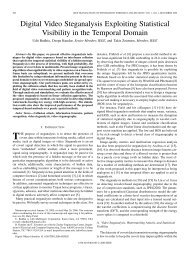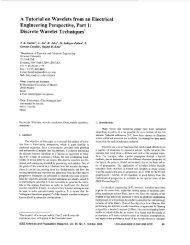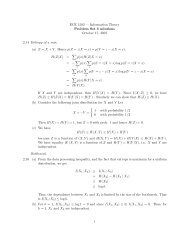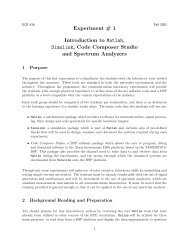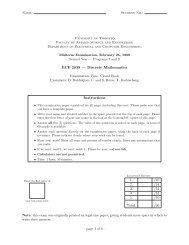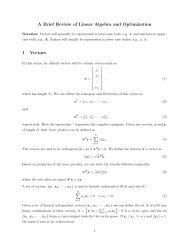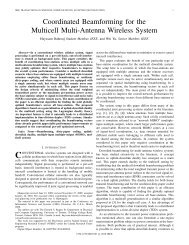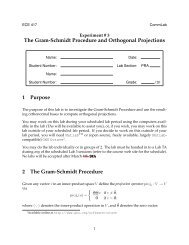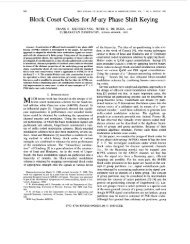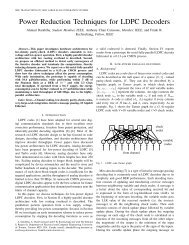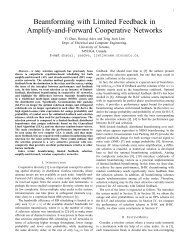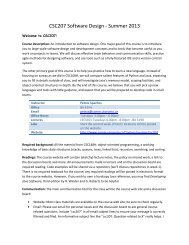On the use of cyber-physical hierarchy for - IEEE Xplore
On the use of cyber-physical hierarchy for - IEEE Xplore
On the use of cyber-physical hierarchy for - IEEE Xplore
Create successful ePaper yourself
Turn your PDF publications into a flip-book with our unique Google optimized e-Paper software.
Normalized Frequency<br />
1.06<br />
1.04<br />
1.02<br />
1<br />
0.98<br />
0.96<br />
G1<br />
0.94<br />
G2<br />
G3<br />
0.92<br />
0 2 4 6 8 10<br />
Time (s)<br />
(a) Normalized frequencies versus time.<br />
Phase Angle (Degree)<br />
500<br />
400<br />
300<br />
200<br />
100<br />
0<br />
G1<br />
G2<br />
G3<br />
−100<br />
0 2 4 6 8 10<br />
Time (s)<br />
(b) Phase angles versus time.<br />
Phase Angle Difference (Degree)<br />
200<br />
150<br />
100<br />
50<br />
0<br />
−50<br />
−100<br />
G1 and G2<br />
G1 and G3<br />
G2 and G3<br />
−150<br />
0 2 4 6 8 10<br />
Time (s)<br />
(c) Phase angle differences versus time.<br />
Fig. 7. Results <strong>for</strong> 3-phase short at Bus 6 when line is removed at t =0.3 s with proposed two-tier hierarchical <strong>cyber</strong>-<strong>physical</strong> control at<br />
t =0.45 s; τ =0.05 s.<br />
Normalized Frequency<br />
1.6<br />
1.5<br />
1.4<br />
1.3<br />
1.2<br />
1.1<br />
1<br />
G1<br />
G2<br />
G3<br />
Phase Angle (Degree)<br />
2.5 x 104 Time (s)<br />
2<br />
1.5<br />
1<br />
0.5<br />
0<br />
G1<br />
G2<br />
G3<br />
Phase Angle Difference (Degree)<br />
1<br />
0.5<br />
0<br />
−0.5<br />
−1<br />
1.5 x 104 Time (s)<br />
G1 and G2<br />
G1 and G3<br />
G2 and G3<br />
0.9<br />
0 2 4 6 8 10<br />
Time (s)<br />
(a) Normalized frequencies versus time.<br />
−0.5<br />
0 2 4 6 8 10<br />
(b) Phase angles versus time.<br />
−1.5<br />
0 2 4 6 8 10<br />
(c) Phase angle differences versus time.<br />
Fig. 8. Results <strong>for</strong> 3-phase short at Bus 6 when line is removed at t =0.3 s with non-hierarchical <strong>cyber</strong>-<strong>physical</strong> flocking control at t =0.4 s;<br />
τ =0.05 s.<br />
tors <strong>of</strong> agents and <strong>the</strong> second layer characterizes <strong>physical</strong> couplings<br />
amongst generators within an agent. Through <strong>the</strong> study <strong>of</strong> a <strong>cyber</strong><strong>physical</strong><br />
flocking-based control protocol on <strong>the</strong> WECC 9-bus system,<br />
we have demonstrated <strong>the</strong> potential <strong>of</strong> <strong>the</strong> approach in reducing<br />
communication and energy overhead required <strong>for</strong> control. This<br />
comes at <strong>the</strong> cost <strong>of</strong> increased computational complexity required<br />
<strong>for</strong> determining generator coherency <strong>for</strong> <strong>the</strong> <strong>for</strong>mation <strong>of</strong> generatorcluster<br />
agents in real-time. However, <strong>the</strong> hierarchical approach reduces<br />
control signal computation and decreases <strong>the</strong> <strong>cyber</strong> coupling<br />
amongst generators relying, in part, on <strong>physical</strong> coherence to achieve<br />
transient stability in <strong>the</strong> face <strong>of</strong> fault or <strong>cyber</strong>-<strong>physical</strong> attacks. We<br />
observe that this reduced <strong>use</strong> <strong>of</strong> in<strong>for</strong>mation makes <strong>the</strong> effective<br />
<strong>cyber</strong>-<strong>physical</strong> system inherently more robust against <strong>cyber</strong> attacks<br />
and in<strong>for</strong>mation delay.<br />
6. REFERENCES<br />
[1] J. Wei, D. Kundur, T. Zourntos, and K. Butler-Purry, “A<br />
flocking-based dynamical systems paradigm <strong>for</strong> smart power<br />
system analysis,” in Proc. <strong>IEEE</strong> Power Engineering Society<br />
General Meeting, San Diego, CA, July 2012.<br />
[2] R. Olfati-Saber, J. Fax, and R. Murray, “Consensus and cooperation<br />
in networked multi-agent systems,” Proceedings <strong>of</strong> <strong>the</strong><br />
<strong>IEEE</strong>, vol. 95, no. 1, pp. 215–233, January 2007.<br />
[3] F. Dörfler and F. Bullo, “Topological equivalence <strong>of</strong> a structurepreserving<br />
power network model and a non-uni<strong>for</strong>m Kuramoto<br />
model <strong>of</strong> coupled oscillators,” in Proc. <strong>IEEE</strong> Conference on Decision<br />
and Control and European Control Conference, Orlando,<br />
FL, December 2011, pp. 7099–7104.<br />
[4] M. Fiedler, “Algebraic connectivity <strong>of</strong> graphs,” Czechoslovak<br />
Ma<strong>the</strong>matical Journal, vol. 23, pp. 298–305, 1973.<br />
[5] A. Seary and W. Richards, Dynamic Social Network Modeling<br />
and Analysis. National Academies’ Press, 2003.<br />
[6] P. Sauer and M. Pai, Power System Dynamics and Stability.<br />
Prentice Hall, 1997.



